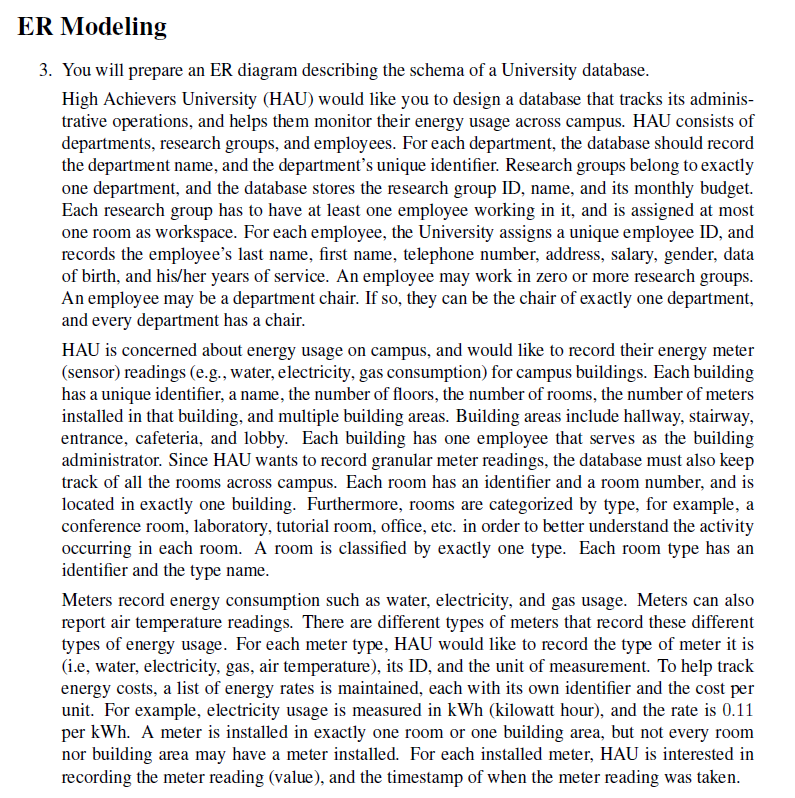ER Modeling
Database Systems: Design, Implementation, & Management
12th Edition
ISBN:9781305627482
Author:Carlos Coronel, Steven Morris
Publisher:Carlos Coronel, Steven Morris
Chapter9: Database Design
Section: Chapter Questions
Problem 7P
Related questions
Question

Transcribed Image Text:ER Modeling
3. You will prepare an ER diagram describing the schema of a University database.
High Achievers University (HAU) would like you to design a database that tracks its adminis-
trative operations, and helps them monitor their energy usage across campus. HAU consists of
departments, research groups, and employees. For each department, the database should record
the department name, and the department's unique identifier. Research groups belong to exactly
one department, and the database stores the research group ID, name, and its monthly budget.
Each research group has to have at least one employee working in it, and is assigned at most
one room as workspace. For each employee, the University assigns a unique employee ID, and
records the employee's last name, first name, telephone number, address, salary, gender, data
of birth, and his/her years of service. An employee may work in zero or more research groups.
An employee may be a department chair. If so, they can be the chair of exactly one department,
and every department has a chair.
HAU is concerned about energy usage on campus, and would like to record their energy meter
(sensor) readings (e.g., water, electricity, gas consumption) for campus buildings. Each building
has a unique identifier, a name, the number of floors, the number of rooms, the number of meters
installed in that building, and multiple building areas. Building areas include hallway, stairway,
entrance, cafeteria, and lobby. Each building has one employee that serves as the building
administrator. Since HAU wants to record granular meter readings, the database must also keep
track of all the rooms across campus. Each room has an identifier and a room number, and is
located in exactly one building. Furthermore, rooms are categorized by type, for example, a
conference room, laboratory, tutorial room, office, etc. in order to better understand the activity
occurring in each room. A room is classified by exactly one type. Each room type has an
identifier and the type name.
Meters record energy consumption such as water, electricity, and gas usage. Meters can also
report air temperature readings. There are different types of meters that record these different
types of energy usage. For each meter type, HAU would like to record the type of meter it is
(i.e, water, electricity, gas, air temperature), its ID, and the unit of measurement. To help track
energy costs, a list of energy rates is maintained, each with its own identifier and the cost per
unit. For example, electricity usage is measured in kWh (kilowatt hour), and the rate is 0.11
per kWh. A meter is installed in exactly one room or one building area, but not every room
nor building area may have a meter installed. For each installed meter, HAU is interested in
recording the meter reading (value), and the timestamp of when the meter reading was taken.
Expert Solution
This question has been solved!
Explore an expertly crafted, step-by-step solution for a thorough understanding of key concepts.
Step by step
Solved in 3 steps with 5 images

Knowledge Booster
Learn more about
Need a deep-dive on the concept behind this application? Look no further. Learn more about this topic, computer-science and related others by exploring similar questions and additional content below.Recommended textbooks for you

Database Systems: Design, Implementation, & Manag…
Computer Science
ISBN:
9781305627482
Author:
Carlos Coronel, Steven Morris
Publisher:
Cengage Learning

Fundamentals of Information Systems
Computer Science
ISBN:
9781337097536
Author:
Ralph Stair, George Reynolds
Publisher:
Cengage Learning

Fundamentals of Information Systems
Computer Science
ISBN:
9781305082168
Author:
Ralph Stair, George Reynolds
Publisher:
Cengage Learning

Database Systems: Design, Implementation, & Manag…
Computer Science
ISBN:
9781305627482
Author:
Carlos Coronel, Steven Morris
Publisher:
Cengage Learning

Fundamentals of Information Systems
Computer Science
ISBN:
9781337097536
Author:
Ralph Stair, George Reynolds
Publisher:
Cengage Learning

Fundamentals of Information Systems
Computer Science
ISBN:
9781305082168
Author:
Ralph Stair, George Reynolds
Publisher:
Cengage Learning

Principles of Information Systems (MindTap Course…
Computer Science
ISBN:
9781285867168
Author:
Ralph Stair, George Reynolds
Publisher:
Cengage Learning